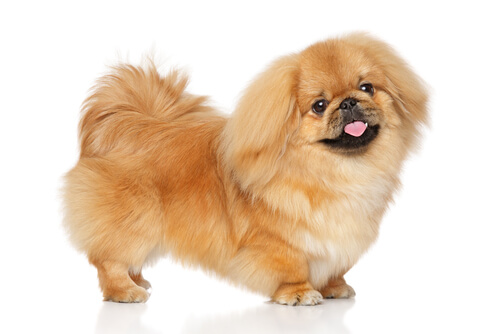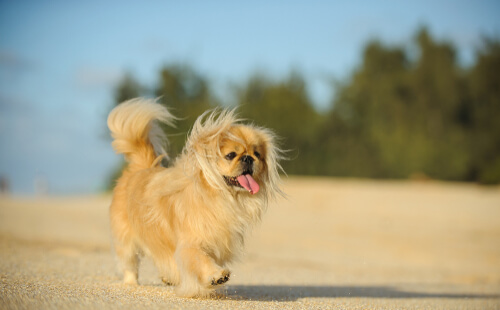
| Kingdom | Animalia |
| Phylum | Chordata |
| Class | Mammalia |
| Order | Carnivora |
| Family | Canidae |
| Genus | Canis |
| Species | C. lupus |
| Species | C. lupus familiaris |
| Niche | Domestic |
| Height | 6-9 inches (15-23 cm) |
| Weight | 7-14 lbs (3.5-6.5 kg) lbs ( kg) |
| Lifespan | 12-15 years |
| Social Structure | Social, domesticated |
| Breed Status | Common (49 of 155, AKC) |
| Preferred Habitat | Domestic |
| Average Litter Size | 2-4 |
| Main Food Item | Dog Food |
The Basics
The Pekingese is a small breed of domestic dogs from China. It has long, coarse fur and, despite its small size, is known as the Lion Dog of China for its fierce and loyal reputation. Dating back over 2 000 years, Pekingese may be among the oldest domestic dog breeds.

Appearance
Pekingese are small and famously adorable. They have round, brown eyes and a long mane of straight hair. Their tails are covered in fur and are carried high over its back. Their coat is thick and long, typically tan or ‘fawn’ color, although any color or combination of colors and markings can occur. Solid white Pekingese are particularly sought after in China. Their coat coarse, with show dogs generally wearing it straight and much longer than that of the typical pet dog. Beneath this topcoat, they have a soft undercoat.
They are common in stature to other popular small breeds such as the Shih Tzu and Chihuahuas. However, standing only 6-9 in (15-23 cm) tall, they are relatively heavy for size, weighing 7-14 lbs (3.5-6.5 kg). In China, any particularly small animals were historically referred to as ‘sleeve dogs’ because they were so small they were able to ride around in the sleeves of the extravagant robes worn by members of the Imperial court of China.
History
Pekingese have existed in China for at least 2 000 years and are named after its capital city Peking (now Beijing). In fact, they are one of the oldest extant dog breeds. Over the centuries they have been kept by noblemen in China and, eventually, by Queen Victoria in England. Eventually, their popularity spread across the Atlantic, and, ultimately, a Pekingese named Rascal was registered by the American Kennel Club in 1906. Currently, they are the 49th most common breed registered by the AKC.
The Pekingese As a Pet
Pekingese are small dogs, making them well suited to apartment living. They are known for their adaptability and willingness to get along with just about anyone. However, they are also known for their tendency to bark. Also wary of strangers, this makes them a good guard dog at alerting their owners although their small stature doesn’t lend itself well to actually protecting from larger threats. However, they are very loyal and will try if necessary.
Pekingese are intelligent but also have an independent streak. Thus, a significant amount of effort is required to properly train them. They are confident – if not cocky – and do not respond well to harsh discipline. Also, their long, thick coats require plenty of brushing and care. Therefore, a patient and experienced owner is best for getting the most out of these popular pets.
Because of their wariness of others, they are not well-suited for families with small children or other animals. That said, as with all dogs, it is important for them to experience plenty of socialization early in life to best curb their less desirable behaviors. Females typically give birth to small litters of about 2-4 puppies, and most individuals live for about 12-15 years.
Fun Facts about Pekingese!

Much Confidence in a Small Package
Despite their small stature, Pekingese are notoriously confident. It should come of no surprise, then, that the breed has been held in high regard in Chinese high society – including the Imperial court of China – for centuries now.
As if still aware of this, members of the breed act very self-important, and will often be the first living thing in the room to greet a newcomer, as if to demand a little attention and homage be paid it. Indeed, they were so respected in Chinese high society that the commanders of great Chinese armies bowed to them when they entered the Imperial Court of China to speak with noblemen.
A Monkey and a Marmoset
With their long association with Chinese royalty, it is hardly surprising that their origin story is literally the stuff of legends. As the tale goes, a lion and a marmoset – a monkey-like animal – fell in love. However, the lion was so much larger than the marmoset that he begged Buddha to make him smaller in order to be with his marmoset lover, but allow him to retain his great lionheart. It is the offspring of these unlikely lovers that are said to have become ‘Fu Lin’, the lion dogs of China, or, as known in the west, ‘Pekingese’.
This legend, although of course biologically false, goes a long way to explaining their feisty nature despite their small statures. It is difficult otherwise to explore the breed’s origin, given that is is among the oldest dog breeds in the world. It is, therefore, easy to understand why a legend stands in the place of a more concrete origin story.
From Peking to Buckingham
Eventually, however, despite centuries of confinement to China and even exclusively the palaces of noblemen, the breed made its way to the West during the Opium War in 1860. When troops entered the imperial palace following the invasion of Peking, 5 members of the breed were among the prizes of war that made their way back to England, including one – named “Looty” – that was given to Queen Victoria herself. By the 1890s, however, more and more of these dogs were being smuggled out of China and eventually became common in England, Europe, and, eventually, North America.
Who’s Snoring?
The Pekingese is even capable of remaining the center of attention while sleeping. Like many other breeds that were bred to have shortened noses and faces, Pekingese suffer from a condition known as brachycephalic airway obstruction syndrome, or BAOS. Their exaggerated facial features, although cute, are accompanied by physiological challenges such as a small trachea narrow nostrils, and a soft pallet, all of which affect their breathing and contributes to their tendency to snore loudly.

